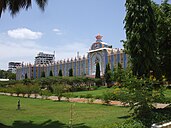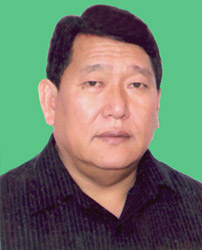I am feeling very sad to inform you that sathya sai baba is no more . He died at the age of 85(born on -
23 November 1926). As per the press release he died today in the morning at 7: 32 a.m.. As i get more information i shall keep you update on this .
| Sri Satya Sai Baba |
|---|
 |
| Date of birth | 23 November 1926 (age 84) |
|---|
| Place of birth | Puttaparthi, Andhra Pradesh, India |
|---|
| Birth name | Sathyanarayana Raju |
|---|
| Date of death | 4 April 2011(aged Expression error: Unrecognised punctuation character "{") |
|---|
| Place of death | patuparthi |
|---|
| Quotation | Love All, Serve All
Help Ever, Hurt Never |
|---|
below i have mention biography of satya sai baba:-
Sathya Sai Baba (
Telugu:
సత్య సాయిబాబా IPA: [sʌθjə sɑːɪ bɑːbɑː]; born as
Sathyanarayana Raju on 23 November 1926
[1]) is a popular
Indian guru,
spiritual figure and educator.
[2] He is described by his devotees as an
Avatar,
godman,
[3] spiritual teacher and miracle worker.
[1][4][5][6][7] The apparent materializing of
vibuthi (holy ash) and small objects such as rings, necklaces and watches by Sathya Sai Baba has been a source of both fame and controversy – skeptics consider these simple conjuring tricks, while devotees consider them evidence of divinity.
[8] Sathya Sai Baba has claimed to be the reincarnation of the great spiritual guru,
Sai Baba of Shirdi, whose teachings were an eclectic blend of Hindu and Muslim beliefs.
[9]
Sathya Sai Baba and his organizations support a variety of free educational institutions, hospitals, and other charitable works in India and abroad. The number of active Sathya Sai Baba adherents was estimated in 1999 to be around 6 million, although followers' estimations are far higher.
[10] Since there are no formal ties of membership, the actual figure may never be known.
[9] The
Sathya Sai Organization reports that there are an estimated 1,200 Sathya Sai Baba Centers in 114 countries worldwide.
[11][12] In India itself, Sai Baba draws followers from predominantly upper-middle-class, urban sections of society who have the "most wealth, education and exposure to Western ideas."
[13] A cultural icon in his home country, Sai Baba has attracted presidents and prime ministers from India and beyond who have become his devotees; in 2002, he claimed to have followers in 178 countries
Sathyanarayana Raju was born to Eswaramma and Peddavenkama Raju Ratnakaram
[16] in the village of
Puttaparthi,
Andhra Pradesh, India.
[9][17] Almost everything known about his life stems from the
hagiography that has grown around him, the presentation of narratives that hold special meaning to his devotees and are considered evidence of his divine nature.
[9][13][18]
His birth, which his mother Eswaramma asserted was by miraculous conception, was also said to be heralded by miracles.
[2][9][19] As a child, he was described as "unusually intelligent" and charitable.
[9] He was exceptionally talented in drama, music, dance and writing, and was an avid composer of poems and plays.
[20] He was said to be capable of materialising objects such as food and sweets out of thin air.
[21][22]
On 8 March 1940, while living with his elder brother Seshama Raju in Uravakonda, Sathya was apparently stung by a scorpion.
[21][22] He lost consciousness for several hours.
[20]Within the next few days there was a noticeable change in Sathya's behavior.
[22] There were "symptoms of laughing and weeping, eloquence and silence."
[22][23] "He began to sing Sanskrit verses, a language of which he had no prior knowledge."
[2] Doctors believed his behavior to be hysteria.
[2][22] His parents brought Sathya home to
Puttaparthi.
[24]Concerned, they took him to many priests, "doctors" and exorcists.
[22][23]
On 23 May 1940, Sathya called household members and materialized sugar candy and other items. His father became furious upon seeing this, thinking his son was
bewitched. He took a stick and asked him who he was. To this Sathya announced calmly and firmly "I am Sai Baba," a reference to Sai Baba of Shirdi.
[2][20] He proclaimed himself to be a reincarnation of Sai Baba of Shirdi—a saint who became famous in the late nineteenth and early twentieth centuries in Maharashtra, and who had died eight years before Sathya was born.
[2][24][25]
Later that year, Sathya Sai Baba declared that he had no worldly relationship with anyone,
[9] and around this time, devotees began to gather to him.
[9] In 1940, Sathya Sai Baba began to travel to Madras and elsewhere in South India and soon had a large regional following.
[9]
In 1944, a
mandir (temple) for Sathya Sai Baba's devotees was built near the village. It is now referred to as the old mandir.
[26][27] The construction of
Prashanthi Nilayam, the current ashram, began in 1948 and after 2 years, was completed in 1950.
[9][27] In 1957 Sathya Sai Baba went on a North Indian temple tour.
[17] In 1954, Sathya Sai Baba established a small free General Hospital in the village of Puttaparthi.
[28]

Sri Sathya Sai University, Puttaparthi, A.P., India
In 1963, Sathya Sai Baba suffered a stroke and four severe heart attacks.
[29] It is believed by some that he healed himself of these, and on recovering announced that he would be reborn as
Prema Sai Baba in the state of Karnataka.
[9] He stated, "I am Siva-Sakthi, born in the gothra (lineage) of Bharadwaja, according to a boon won by that sage from
Siva and
Sakthi. Siva was born in the gothra of that sage as Sai Baba of Shirdi; Siva and Sakthi have incarnated as Myself in his gothra now; Sakthi alone will incarnate as the third Sai (
Prema Sai Baba) in the same gothra in
Mandya district of Karnataka State."
[9][30]
On 29 June 1968, Sathya Sai Baba made his first and only trip overseas, to Uganda.
[29][31] During a discourse in
Nairobi, Sathya Sai Baba stated, "I have come to light the lamp of
Love in your hearts, to see that it shines day by day with added luster. I have not come on behalf of any exclusive religion. I have not come on a mission of publicity for a sect or creed or cause, nor have I come to collect followers for a doctrine. I have no plan to attract disciples or devotees into my fold or any fold. I have come to tell you of this unitary faith, this spiritual principle, this path of
Love, this virtue of
Love, this duty of
Love, this obligation of
Love."
[32] In 1968, he established Dharmakshetra or Sathyam Mandir in Mumbai.
[33]
In 1973, he established Shivam Mandir in Hyderabad.
[33] On 19 January 1981, in Chennai he inaugurated the Sundaram Mandir.
[33] In March 1995 he started the water project to provide drinking water to 1.2 million people in the drought-prone Rayalaseema region in Anantapur.
[34] In 2001 Sathya Sai Baba established another free Super Speciality hospital in Bangalore to benefit the poor.
[28] In April 1999 he inaugurated the Ananda Nilayam Mandir in Madurai, Tamil Nadu.
Since 2005, Sathya Sai Baba has used a wheelchair and his failing health has forced him to make fewer public appearances. In 2006 he suffered a fractured hip when a student standing on an iron stool slipped, and both boy and stool fell on Sathya Sai Baba. He gives
darshan now from a car or his porte chair.
[35][36]
Sathya Sai Baba's assertion of
divine status is expressed in the first person; he states it boldly and repeatedly.
[9] "I am beyond the reach of the most intensive enquiry and the most meticulous measurement. Only those who have recognized my love and experienced that love can assert that they have glimpsed my reality. Do not attempt to know me through the external eyes."
[37]
He is also known as a singer, having released several CDs of bhajans (devotional songs).
[38]
It was reported that Satya Sai Baba was admitted to the super-specialty hospital at Prashantigram at Puttaparthi on March 28, 2011 following respiration-related problems.
[39] As per the April 5th, 2011 evening bulletin reported in the Times Of India "Sai Baba continues to be in a stable condition. All other vital parameters are normal and satisfactory. He is under constant watch of a panel of experts. However, he continues to be on ventilator". This was released by the doctors at the Sri Satya Sai Institute of Higher Medical Sciences (SSSIHMS). It was also reported that he is responding to CRRT and that his heart beat and BP have improved and continues to be on continuous renal replacement therapy (CRRT).
[40]





